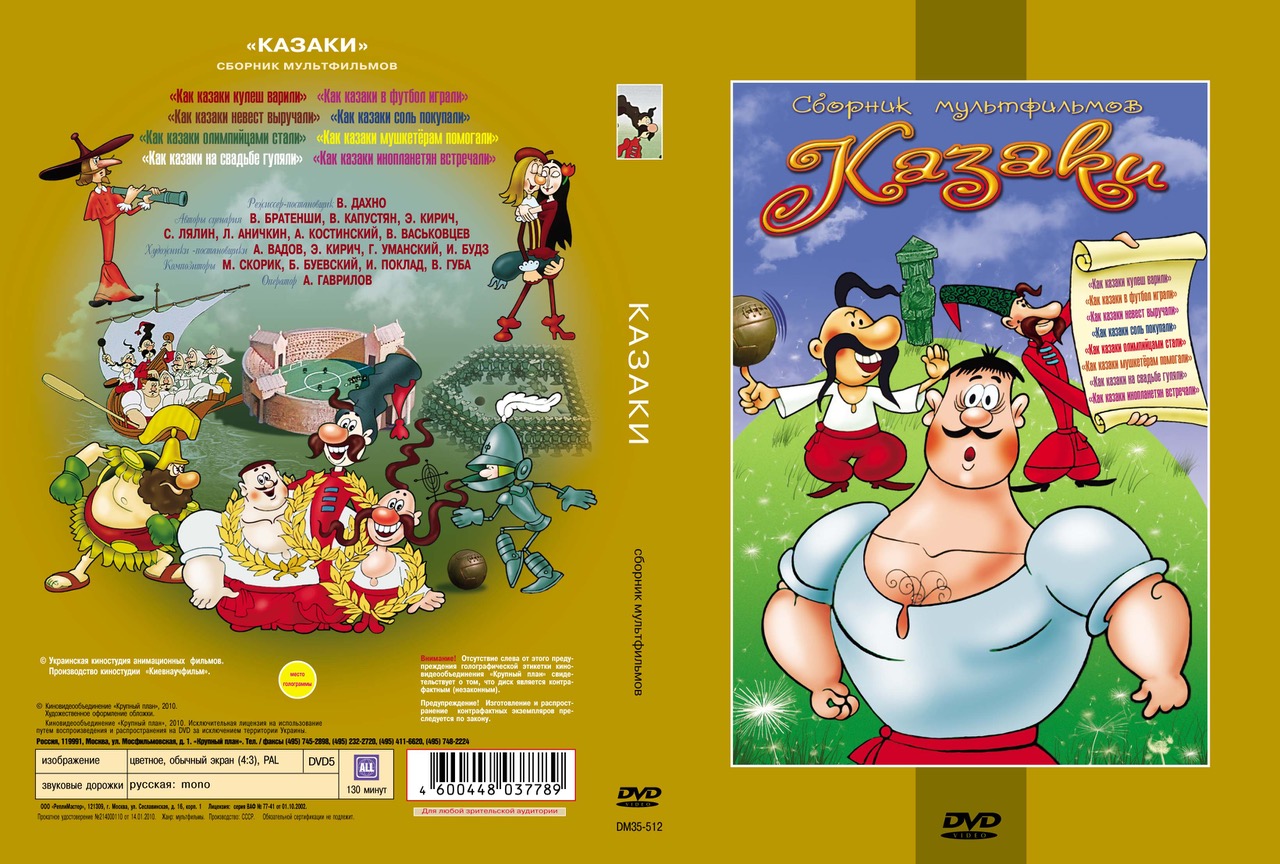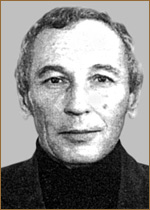Title of the work
Studio / Production Company
Country of the First Edition
Original Language
First Edition Date
First Edition Details
Як козаки наречених визволяли [How Cossacks Rescued Brides (Iak kozaky narechenykh vyzvolialy)]. Directed by Volodymyr Dakhno, written by Volodymyr Kapustian. Composer Ihor Poklad. Kyiv: Kyivnaukfilm, 1973.
Running time
Date of the First DVD or VHS
Awards
1973 – Visions du Réel [Visions of Reality], the 6th International Documentary Film Festival in Nyon (Switzerland) – Sesterce d’argent
Genre
Animated films
Hand-drawn animation (traditional animation)*
Humor
Short films
Target Audience
Children (6+)
Cover

The DVD cover courtesy of Film Video Association “Крупный план” [Close-up (Krupnyĭ plan)] close-up.ru (accessed: February 4, 2019).
Author of the Entry:
Hanna Paulouskaya, University of Warsaw, hannapa@al.uw.edu.pl
Peer-reviewer of the Entry:
Dorota Mackenzie, University of Warsaw, dorota.mackenzie@gmail.com
Elizabeth Hale, University of New England, ehale@une.edu.au
Elżbieta Olechowska, University of Warsaw, elzbieta.olechowska@gmail.com

The portrait of Volodymyr Dakhno courtesy of kino-teatr.ru database.
Volodymyr Dakhno
, 1932 - 2006
(Animator, Director)
Dakhno Volodymyr (Дахно Володимир; Дахно Владимир; Dakhno Vladimir) – a famous Ukrainian animator, director, People’s Artist of Ukraine.
Volodymyr Dakhno studied architecture (1955) and came to animation in 1960s in collaboration with another architect, Mark Draitsun (also an animator of the “Cossack” series).
The most famous of his animations are movies from the series “Cossacks”, which became a trademark of the Ukrainian animation studio “Kyivnauchfilm”.
Bio prepared by Hanna Paulouskaya, University of Warsaw, hannapa@al.uw.edu.pl
Summary
The movie is the third in a series about Cossacks produced by Volodymyr Dakhno. The series depicts adventures of three brave Cossacks: Grai, Oko and Tur.*
The movie tells the story of Ukrainian young girls kidnapped by pirates. The girls are dressed in national costumes; singing a traditional Ukrainian song about the Sun, they float wreaths of cornflowers on a river, most probably celebrating the Kupala Night (the night of the Summer Solstice, the shortest, magical night in Slavic tradition). Three of the girls are the beloved of the three Cossacks.
From their ship, the pirates see the girls and the wreaths and kidnap them. The Cossacks start chasing the pirates.
The pirates flee to very distant lands: Ancient Greece, Ancient Egypt and India. The Cossacks follow them everywhere.
In the end the pirates bring the girls to their castle on a rock, and the Cossacks dressed as musicians come to their party. With a song, they lure the pirates to come downstairs to a cellar and confine them there. They save the girls by stealing the pirates’ ship.
* More about the characters in description of another movie from the series Як козаки олімпійцями стали [How Cossacks Became Olympians (Iak kozaki olimpiĭtsiami stali)].
Analysis
The use of Ancient Greece among other “exotic” places is the reason for analyzing this animation in the Survey. It is the first movie in the series, where the ancient topic appears. However connections between the Cossacks and the ancient world have a longer tradition in Ukraine started by Ivan Kotliarevsky in the late 18th century.*
The girls are depicted in the most “Ukrainian” way. They are dressed in traditional costumes, have wreaths on their heads, sing traditional songs. Most probably they celebrate the Kupala Night (June 24 or July 6 in the Julian calendar). It was an old pagan holiday, highly popular among East Slavic nations. In some measure it is celebrated till today, after becoming part of the Feast of St John the Baptist. There is a lot of fortune telling connected to this Feast, most of them are performed by young girls who wish to predict their weddings. Betrothed girls usually make wreaths of cornflowers. And in the movie we see how the girls put their wreaths on the river and the images of Grai, Oko and Tur appear inside the wreaths. This shows that three of the girls are the loved ones of the three Cossacks, and they make their predictions about their suitors. This also clarifies the title of the movie which calls the girls “brides”.
There is another Slavic custom – to “kidnap” a bride during the wedding. The bridegroom should find the bride and ransom her from the kidnappers, proving his love.
Thus Ukraine is depicted as a nation preserving the traditions and customs.
The depiction of Ancient Greece is very stereotypical and consists of a few images.
In the beginning we see a Greek temple, which appears to be part of a gramophone. So we see Greeks sitting in circle around the gramophone and happily listening to music. They are dressed in red chitons and have beards.
Afterwards we see a discobolus throwing his discus standing on a capital of a Corinthian column. He is naked and is being watched by the public sitting on the stairs. The landscape is marble-white and seawater-blue. There are statues everywhere.
The next image presents runners following each other in a theatrical manner. They run very slowly and make gestures imitating vase painting. In the background we see Greek temples and a road sign “Marathon – 2 km” attached to a column. The runners are going to Marathon.
Then we see two men among the statues. One wants to buy a vase and is uncertain which one to choose. The seller puts vases in the hand of a goddess’ statue nearby trying to display them the most attractively.
A weightlifter lifts a barbell and gains applause from the public. He makes a low, theatrical bow.
We also see an image of Greece drawn like a map, consisting of many small islands.
When the pirates arrive, all order is disturbed. They steal the gramophone, as well as the discus – even the public disappears. They steal both the vases and hands from the statue, so it looks in more “ancient” style. The barbell vanishes; the pirates turn the runners, so they start to run in the opposite direction.
On the pirate ship we see a capital of a column and a laurel wreath on the head of the captain.
Thus the main stereotypes of Greece are sports, statues, theatre and leisure culture. It is also important that everything had its order before the pirates. Greece is shown as a place of white marble, calm and order. However the pirates do not destroy it, they only steal some elements. When the Cossacks come, we see the same temples, houses and sculptures on the same islands. Greeks indicate the way for the Cossacks, and they continue their pursuit. The Cossacks do not make any changes in the Greek landscape; they do not even go ashore.
The pirates were also part of ancient Greek reality. However, the pirates of the movie do not correspond to those of the ancient world but are drawn in standard animation style.
* See the analysis of How Cossacks Became Olympians in the database as well as analysis of the poem of Kotliarevsky prepared by Maria Pushkina.
Further Reading
Paulouskaya, Hanna, “Virgil travestied into Ukrainian and Belarusian”, in The Afterlife of Virgil, Peter Mack and John North, eds., Bulletin of the Institute of Classical Studies, Supplement, 136. London: Institute of Classical Studies, 2017, 101–122.
Pushkina, Maria, "Entry on: Aeneid. Travestied Inside Out into Little Russian language by I. Kotliarevsky [Енеида. На малороссійскій языкъ перелиціованная И. Котляревскимъ (Eneida. Na malorossiĭskiĭ iazyk perelitsiovannaia I. Kotlarevskim)]," peer-reviewed by Elżbieta Olechowska and Susan Deacy, in Our Mythical Childhood Survey, Warsaw: University of Warsaw, 2018. Link: http://omc.obta.al.uw.edu.pl/myth-survey/item/513.
Addenda
The Remaining Production Credits
Art director – Ivan Mazepa,
Second director – Eduard Kyrych,
Animators – M. Draitsun, A. Pedan, A. Viken and others,
Sound director – I. Moizhes,
Camera man – Anatoly Gavrilov,
Composer – Ihor Poklad.
Information about the film in movie databases:
kinopoisk.ru (accessed: February 4, 2019).
imdb.com (accessed: February 4, 2019).
kino-teatr.ru (accessed: February 4, 2019).
animator.ru (accessed: February 4, 2019).


